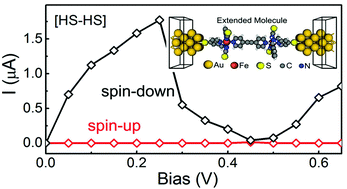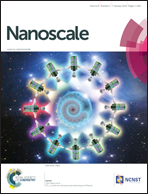Coherent transport through spin-crossover magnet Fe2 complexes†
Abstract
As one of the most promising building blocks in molecular spintronics, spin crossover (SCO) complexes have attracted increasing attention due to their magnetic bistability between the high-spin (HS) and low-spin (LS) states. Here, we explore the electronic structures and transport properties of SCO magnet Fe2 complexes with three different spin-pair configurations, namely [LS–LS], [LS–HS], and [HS–HS], by performing extensive density functional theory calculations combined with the non-equilibrium Green's function technique. Our calculations clearly reveal that the SCO magnet Fe2 complexes should display two-step spin transitions triggered by external stimuli, i.e. temperature or light, which confirm the previous phenomenological model and agree well with previous experimental measurements. Based on the calculated transport results, we observe a nearly perfect spin-filtering effect and negative differential resistance (NDR) behavior integrated in the SCO magnet Fe2 junction with the [HS–HS] configuration. The current through the [HS–HS] SCO magnet Fe2 complex under a small bias voltage is mainly contributed by the spin-down electrons, which is significantly larger than those of the [LS–LS] and [LS–HS] cases. The bias-dependent transmissions are responsible for the observed NDR effect. These theoretical findings suggest that SCO Fe2 complexes hold potential applications in molecular spintronic devices.


 Please wait while we load your content...
Please wait while we load your content...